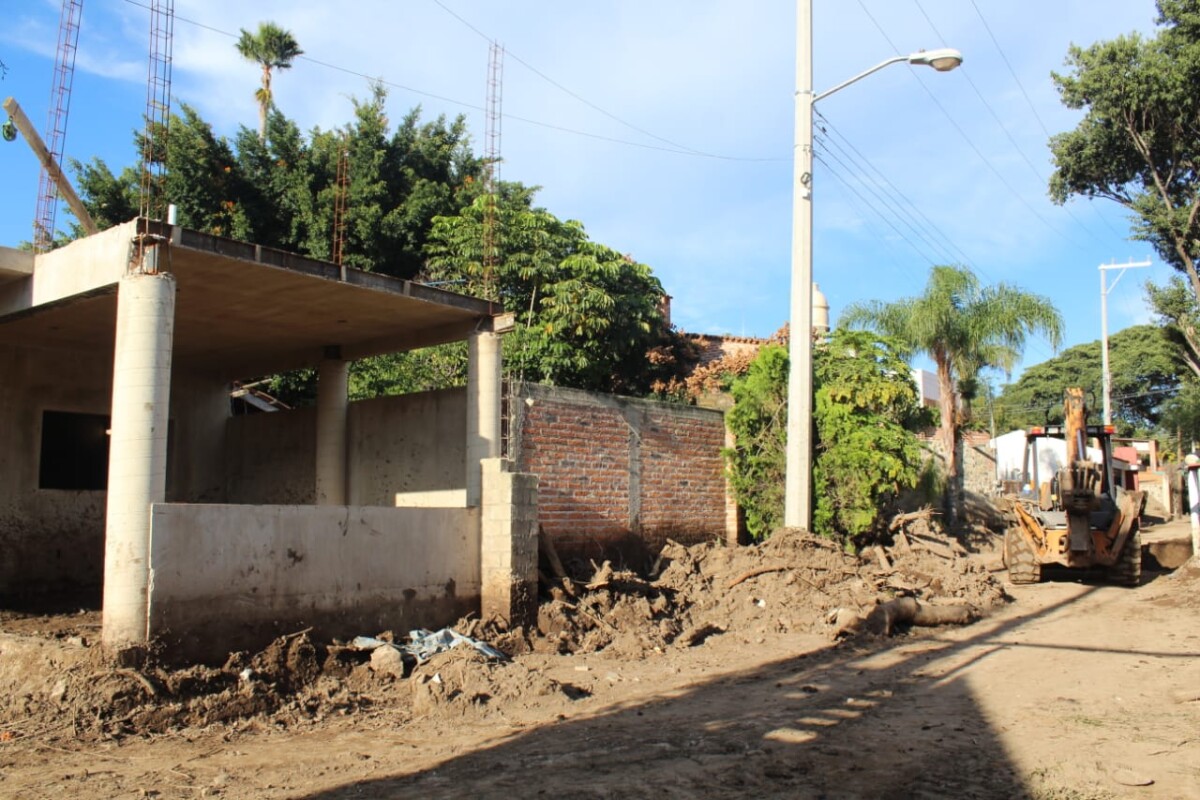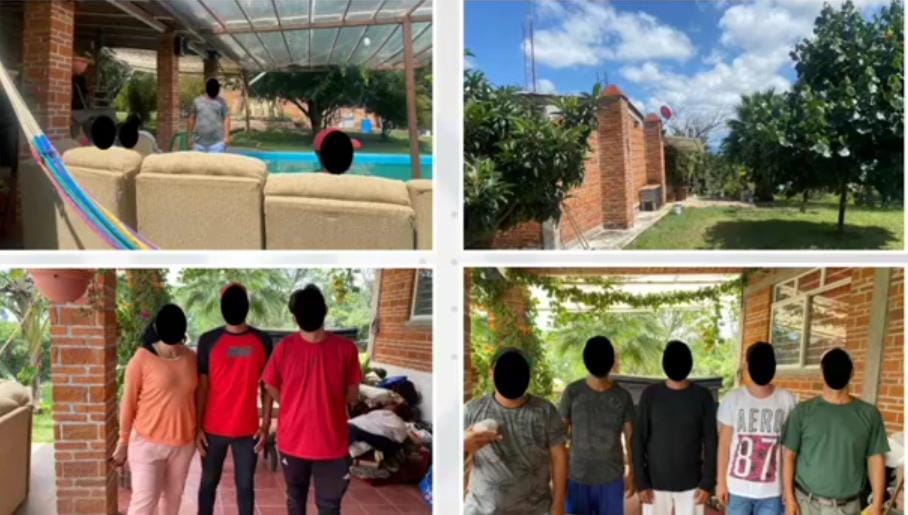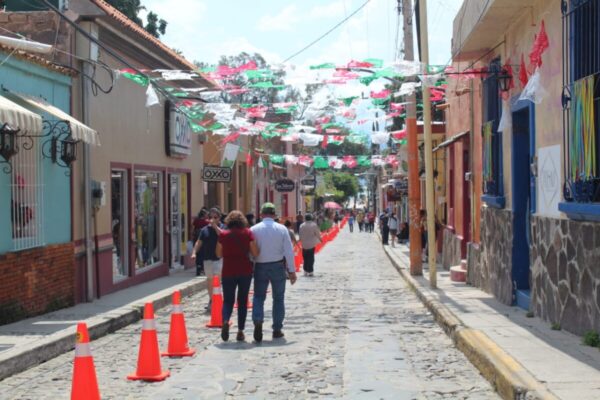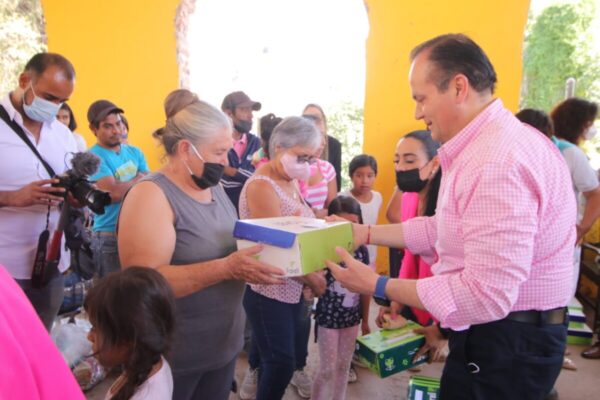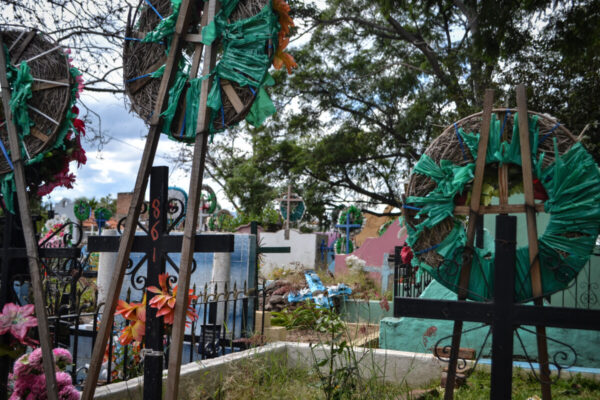Localidades
New administration supports resuming recycling project
Team of volunteers working on this project on Saturdays. The project is in El Bajío, on the outskirts of Ajijic. Photo: María del Refugio Reynoso Medina.
Sofía Medeles (Ajijic, Jal.) – Ajijic’s recycling project, which began operating without support from City Hall during 2019, has the support of the new Chapala administration, according to Ajijic’s Encargado de Despacho, Maximiliano “Max” Macías Arceo. He said the project would receive support, transportation and personnel from the municipality.
 “The people from the recycling center, who are Americans, have already approached us to ask for support. The truth is that the place (located on the Chapala-Jocotepec highway at El Bajío) is in a deplorable state, the bathrooms do not work and there is a garbage dump. We want to work more closely with them since they help us keep the streets looking good. We will try to reestablish the relationship and lend them a vehicle and an assistant,” Macías Arceo said.
“The people from the recycling center, who are Americans, have already approached us to ask for support. The truth is that the place (located on the Chapala-Jocotepec highway at El Bajío) is in a deplorable state, the bathrooms do not work and there is a garbage dump. We want to work more closely with them since they help us keep the streets looking good. We will try to reestablish the relationship and lend them a vehicle and an assistant,” Macías Arceo said.
He also said an American company has donated 42 garbage drums, but he does not know how large the drums are. He wants to be sure they are big enough to avoid overflowing, especially due to use by tourists. That could look bad and also hinder collection. On the other hand, he expressed confidence that blue bins, which are used to collect items for recycling, will soon be repaired with the help of Alberto Muñoz Hernández “Beto Rock.”
Thomas Thompson, a volunteer who led the project when it began, told Laguna that the relationship with the past Municipal Government is broken. He said the program has continued because the volunteers have been supporting it unconditionally.
Thomas said the project, which today is sustainable thanks to the sale of cardboard, glass and plastic, manages to pay an employee. From time to time, volunteers are able to set up educational projects for children. Even so, sometimes the resources are not enough because they need to budget for the transfer of recyclable waste from the town to the collection center and then send the materials to recyclers in Guadalajara.
The activist said he and his fellow volunteers have continued for almost four years with the motivation to create a more sustainable world, prevent landfills from filling up with garbage and take advantage of the resources that can be reused.
 The recycling project began in 2018, when the former administration of the Municipal Government of Chapala (2018-2021) convened in the main square to form a committee, with Thomas Thompson leading the effort. The project stopped in April 2020; however, it partially resumed work in July of that same year.
The recycling project began in 2018, when the former administration of the Municipal Government of Chapala (2018-2021) convened in the main square to form a committee, with Thomas Thompson leading the effort. The project stopped in April 2020; however, it partially resumed work in July of that same year.
Volunteers are accepted on Saturdays from 9 a.m. to 2 p.m. at the bodega located at Chapala-Jocotepec Highway #915 A, in El Bajío.
Translated by Mike Rogers
La Cristina, the most forgotten area after the mudslides
Residents of La Cristina say they are not receiving support from the City Hall to clean the street, and that, until recently, the DIF and civil organizations have supported them with food.
Sofía Medeles (Ajijic, Jal.)- A week after the mudslides in the west of Ajijic, the neighborhood of La Canacinta is already in better condition, with clean streets and every day with fewer traces of the damage caused by the October 5 disaster.
 However, the neighborhood of La Cristina has not fared as well, as the neighborhood (also west of town) was difficult to access due to the mud blockage until the beginning of the week.
However, the neighborhood of La Cristina has not fared as well, as the neighborhood (also west of town) was difficult to access due to the mud blockage until the beginning of the week.
Residents of La Cristina told Laguna that since the day of the mudslide (which flooded at least five neighborhoods), and up to now the authorities have not helped them clean up with heavy machinery, they have had to do it themselves.
«They say they can’t come to clean up here because it is a private street. The heavy machinery that has come to open our street has been because the neighbors paid for them,» said one of the neighbors interviewed.
«Until the beginning of this week, the DIF and social organizations supported us with food supplies and some clothes, because the first week no one stopped by to see how the residents were doing. One family even had to sleep in their car, since their house had been buried in the mud and they had nowhere to go. Here the disaster was the same or even worse than in La Canacinta, since walls were also burst and the mudslide left boulders», said a neighbor of La Cristina.
In a tour made by Semanario Laguna on October 13, the people who live in La Cristina were still cleaning their homes and streets, and picking up the garbage that the current left behind. In addition, the mud, which according to the marks on the walls, reached more than one meter high, has begun to expel foul odors.
In nearby La Canacinta, the streets are already free of landslide damage and some households continue with cleaning their homes. At the beginning of the week, neighbors of La Canacinta also received medical support from Servicios Medicos de Chapala, because people began to present respiratory and stomach infections due to the contact with the mud. The Axixic Chimalli group, along with many other civilians, donated the medicines. They also received household appliances, beds, clothes and food from donations by private individuals.
Translated by Kerry Watson
Aseguran 27 motocicletas en Ixtlahuacán de los Membrillos durante un operativo
Motos aseguradas sobre una grúa. Foto: Fiscalía.
Redacción.- La falta de documentos o la placa de circulación fue el motivo del aseguramiento de 27 motocicletas, mediante el operativo para regularizar vehículos realizado en Ixtlahuacán de los Membrillos por la Comisaría de la Policía Vial de la Secretaría de Seguridad del Estado, en coordinación con la Comisaría de la Policía municipal.
El dispositivo se realizó el 20 de octubre en Ixtlahuacán y la delegación de Atequiza, donde los oficiales de ambas corporaciones supervisaron a los conductores de vehículos y motocicletas, resultado en la detención de las 27 motos debido a que los conductores incurrieron en irregularidades, como la falta de documentos o la placa de circulación.
El operativo de regularización de vehículos tiene como objetivo concientizar a motociclistas y automovilistas sobre el cumplimiento de la ley, así como lograr un ordenamiento vial e inhibir acciones delictivas que pongan en riesgo el patrimonio y la seguridad de las y los jaliscienses.
Ajijic’s new Delegado will seek to work in an integrated manner
Ajijic’s new Delegado or town administrator, Maximiliano «Max» Macías Arceo, 43 years old, is a native of the town and son of Alicia Arceo and Maximiliano Macías «Chimiano.» Photo Sofia Medeles.
Sofía Medeles (Ajijic, Jal.)- The new Delegate of Ajijic, Maximiliano «Max» Macías Arceo, 43 years old, said in an interview that he will work in an integrated manner in different areas, as well as in public services so that they work as they should. 
The interviewee’s medium-term plan is to promote culture and traditions, sports and to keep the basic services of the town fully functioning; in other words, «to make thins work in Ajijic.»
The Delegado says his main objective is to keep Ajijic’s public lighting, water service and garbage collection in good condition and fully functional. In addition, he is asking that a portion of the annual water collection fee be kept directly in Ajijic and not go to the municipal seat as was the custom in recent administrations.
«I would like part of the annual collection of the Municipal System of Drinking Water and Sewage (SIMAPA) to stay in Ajijic, as it was done before, so we can maintain everything well, without any potholes and with dedicated crews to focus on Ajijic, its streets, and its people,» he said.
Max, who was dressed in jeans and a t-shirt, the attire of a person who likes to work outside the office, recounted some social programs of the past that he would like to replicate, such as that of the Japanese Juanita Reed, who had a crew of children who picked up the garbage from the streets of the town.
«I would like to do something similar to Juanita’s children, who used to bring them cleaning in their white shirts, because education and the culture of cleanliness begins as a child,» he added.
As for sports, he plans to look for a young person who can take charge of organizing and promoting short tournaments in different disciplines, such as basketball and volleyball.
With respect to culture, the Delegado says he will seek to promote activities in coordination with the director of Culture of Ajijic (a new position created in the organization chart of this new government administration), Santiago Baeza, who, with «his contacts and experience», could help him in this task. In addition, he will work with the administrator of the Ajijic Cultural Center (CCA), Héctor Hinojosa, and the local director, Efrén González.
«We are also interested in holding events and activities on the plaza, using it to promote our culture», said the Delegate.
Max asserted: «I don’t want to focus on just one thing, since everything is a priority, especially the people and their needs. Even so, as for the upcoming festivities, we will have to wait to see what the Jalisco Ministry of Health (SSJ) indicates, but we are ready to help everyone.»
As to the election of the delegate, he said that it will be announced in due time, since it is usually in April, where he will participate as a candidate. «Even so, the municipal president has the final word,» he said.
Translated by Kerry Watson
Jalisco District Attorney’s Office Checks Rehabilitation Centers in Chapala
Photo: Jalisco Prosecutor’s Office file.
Redaccion.- The Jalisco Prosecutor’s Office carried out an operation to check rehabilitation centers in Chapala. They were looking to locate people reported as missing, or potentially using the centers to hide from the law..
 The Jalisco Prosecutor’s Office acted on information provided by the Jalisco Prosecutor, Gerardo Octavio Solis. Solis gave a virtual press conference during which he provided information about the operation; he didn’t have any data regarding how many people were located, or if irregularities were found.
The Jalisco Prosecutor’s Office acted on information provided by the Jalisco Prosecutor, Gerardo Octavio Solis. Solis gave a virtual press conference during which he provided information about the operation; he didn’t have any data regarding how many people were located, or if irregularities were found.
On August 18, four men who had been reported missing were found in the «Under the Tree Juvenil Casa H. Hood» center in Chapala.
Translated by Amy Esperanto
Controversial Andador Cultural Axixic returns
Last weekend, cones were placed to prevent people from parking, in preparation for the return of the Andador Cultural Axixic. Photo: Sofía Medeles.
Sofía Medeles (Ajijic, Jal.) – The current Encargado de Despacho of Ajijic, Maximiliano «Max» Macías Arceo, says there are plans to reinstall the andador on Calle Morelo, in the heart of Ajijic. He added that the reinstallation will not only benefit businesses, but also locals and tourists.
(Note: An “anador” means a walkway. In this case it is a “cultural walkway” of outside vendors, in front of existing shops on Calle Morelos)
Macías Arceo continued, «this time, we are planning for it to be a cultural walkway, focused on the local artisans, and the businesses of Calle Morelos.” He said he understands the objections some people have to the project; the previous administration (2015-2018) led a similar project. Objectors felt the previous version of the andador benefited the businesses located along Calle Morelos, but not the local artisans. Another objection is that the andador means Calle Morelos is closed to vehicular traffic on the weekends to make way for the vendors and pedestrians.
Since the new administration (PAN) took office, there has been speculation about if, or how the andador would return. In preparation for the revival of the andador, road agents have been in charge of preventing vehicles from parking on Calle Morelos, beginning at the intersection of Morelos and Ocampo.
In the first two weeks of the previous government (Ciudadano Movimiento), the andador was closed; seven street vendors were relocated close to the pier, at the entrance of the Ajijic malecón. There are now more than twenty street vendors selling at the new location.
When 17 people were interviewed about the return of the Andador Cultural Axixic, nine of them supported the re-opening, while eight others were opposed to closing a main street again for the sale of handicrafts. Francisco, a young resident of Ajijic, said «they are only giving way to the restaurants to bring their filth back to the streets little by little. They may say it is to support local culture, but they said the same thing last time. It’s good that they are fixing the street, but with the stalls there, they are only going to cause traffic chaos.»
On the other hand, those who support the re-opening,seem confident that it could be a profitable platform for local artists. «A cultural walkway, like the one in the plaza, but exclusively for people from Ajijic, is what the town needs. Ajijic has many artists who should have more visibility to those who come to visit our pueblo mágico,» commented Fany, an Ajijic resident.
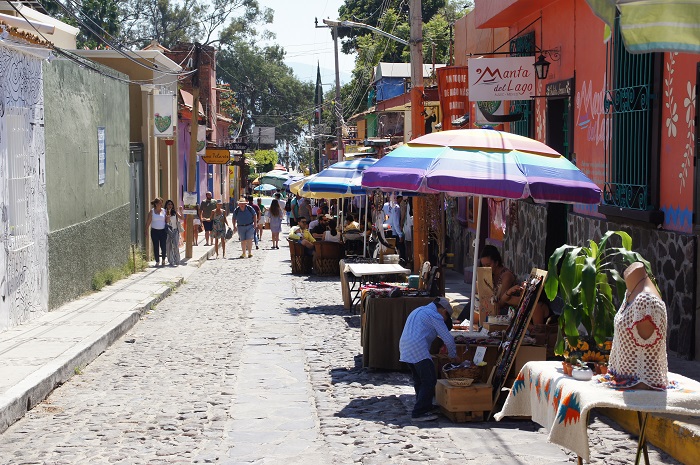
Andador Axixic, in 2017. Tables from restaurants and shops line the street for outdoor shopping, and dining. (Photo: Archive).
The new Municipal President, Alejandro Aguirre, is aware of the mixed opinions. His administration is also looking to fix Calle Morelos starting at Calle Colón, always taking the opinions of the people into account. Macías Arceo says that the project should begin later this year. The Andador Cultural Axixic was started during the PRI administration by PRI member Javier Degollado. It had been cancelled during the Ciudadano Movimiento administration.
Translated by Amy Esperanto
Aguirre will investigate hillside subdivisions; locals will watch that he keeps his word
The Alebrijes subdivision is accused of reducing a riverbed from eight meters to approximately one-and-a-half meters, which is now clear of mud.
Sofía Medeles (Ajijic, Jal.) – After the October 5 mudslides, some residents of La Canacinta in Ajijic accused the subdivisions at the foot of the hill of actions that made the mudslides worse. The accusations were made to the Chapala president, PAN member Alejandro Aguirre Curiel, during his October 8 tour of the areas affected by the landslide. He assured residents that he would take action on the matter, and some neighbors told Laguna they expect the president to keep his word. 
Aguirre Curiel committed himself to “open, review and corroborate permits,” and find out who gave permission to build in these areas. He focused on the Alebrijes subdivision, located in La Canacinta to the west of Ajijic, which has been accused of increasing the landslide problem because it reduced the flow of a stream that crosses the development.
Neighbors in the area, as well as Ajijitecos who have supported victims of the October 5 landslide, were happy with the news but they warn they expect action.
“It is good that they are going to investigate this. They’ve been saying that for a long time, but it is up to us to check that they follow up because they promise things and then are silent. We will continue asking the president and the officials how they are doing with the case until they find the guilty parties and can remedy the damage caused by the overflowing of the stream,” said Sarahí, a resident of Ajijic who provided medicines for landslide victims.
“It is good that they are working to find the culprits. The damage has already happened, but let’s hope that it doesn’t happen again and that not only are those responsible found, but that they themselves are responsible for paying for the damages that happened due to the foolishness of wanting to gain a few meters for their main street,” said a neighbor, referring to the Alebrijes subdivision.
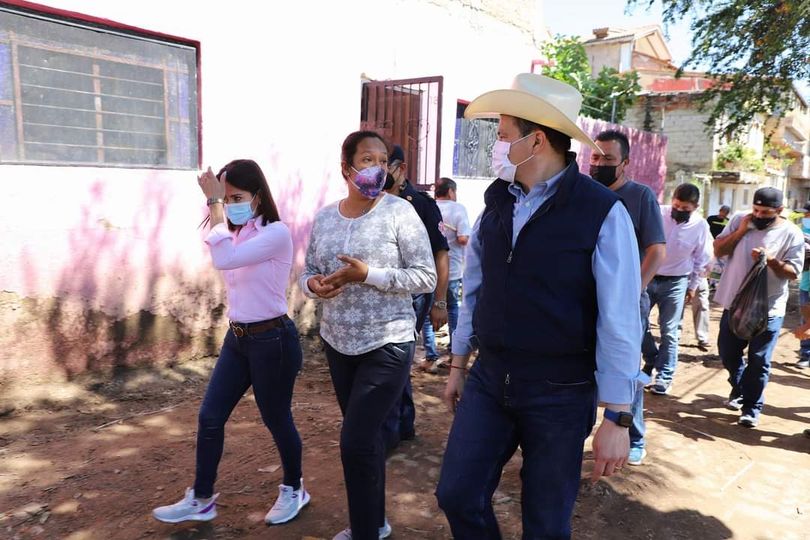
Wearing a hat and dressed in blue, Chapala president Aguirre visited La Canacinta on October 8.
Aguirre commented that the next step is to carry out damage evaluations in affected homes, which will be done by the State Unit of Civil Protection and Firefighters (UEPCyB), Civil Protection and Firefighters of Chapala, and Public Works. In addition, an emergency declaration has been submitted to the state government to access the State Fund for Natural Disasters (FOEDEN) and support the affected homes. No action has been taken yet on the declaration.
Apoyos del FOEDEN solo beneficiaría a 42 viviendas de Ajijic
El alcalde de Chapala durante la entrega de apoyos a habitantes de La Canacinta, durante la mañana del 19 de octubre. Foto: Luilli Barón.
D. Arturo Ortega. – Solo 42 viviendas de las 150 afectadas, en Ajijic por las lluvias torrenciales del cinco de octubre, podrían acceder a los apoyos del Fondo Estatal de Desastres Naturales (FOEDEN).
El motivo de ello es que Protección Civil del Gobierno del Estado solo tiene registradas daños en solo 42 viviendas, mientras que el ayuntamiento contabiliza las afectaciones en al menos 150 hogares.
Los apoyos estatales serían solo para las personas que perdieron todo su menaje, es decir; electrodomésticos y daños estructurales severos en su vivienda, según informó el alcalde de Chapala, Alejandro de Jesús Aguirre Curiel.
En una visita al barrio afectado de La Canacinta acontecida el 19 de octubre, el munícipe realizó entrega de despensas, cobijas, zapatos y otros enceres a las personas damnificadas a quienes señaló que aún se trabaja en la gestión de los recursos del Fondo de Desastres y se desconoce cuándo llegarían estos.
Busca la información completa en la edición impresa de Semanario Laguna La Noticia Como Es.
Capturan a cinco presuntos narcomenudistas en Chapala, Tlaquepaque y Ojuelos
Foto: Fiscalía del Estado de Jalisco.
Redacción.- Policías del Estado de Jalisco realizaron la captura de cinco presuntos narcomenudistas en los municipios de Chapala, Tlaquepaque y Ojuelos.
En Chapala, sobre la calle Francisco I. Madero, a la altura de Pepe Guízar de la colonia Centro, capturaron a quien se identificó como Jaime Alfredo “N”, de 31 años, presunto portador de dos bolsas con cierre hermético que contenían cristal, las cuales ocultaba en una caja metálica tipo cigarrera.
los policías arrestaron a Sergio Osvaldo “N”, de 28 años, en la esquina de las calles Guayaba y Pomarrosa de la colonia Las Huertas, en Tlaquepaque. El sujeto presuntamente portaba 14 envoltorios con droga sintética que ocultaba en una mochila.
En una segunda acción, los oficiales detectaron a quien dijo llamarse José Carlos “N”, de 29 años, en Hornos y Huertas de la colonia Centro, también el Tlaquepaque, a quien le aseguraron 10 bolsas resellables con cristal que llevaba envueltas en una hoja de papel.
Y en la colonia San Pedrito de Tlaquepaque, en la esquina de Poza Rica y Tecamachalco, arrestaron a Osvaldo Gabriel “N”, de 26 años, a quien sorprendieron en presunta posesión de una bolsa con droga sintética.
Una detención más se registró en el camino que conduce a la empresa La Secadora, en el municipio de Ojuelos, donde fue capturado Julio César “N”, de 31 años, por la presunta portación de diez envoltorios con droga de diseño.
En todos los casos, los detenidos fueron remitidos ante el agente ministerial de la Fiscalía del Estado, donde ya los investigan.
Vandalism in the cemetery of San Juan Cosalá is on the decline
Some of the oldest graves in the cemetery date back to 1861. Photo: Héctor Ruiz.
Héctor Ruiz. – In the San Juan Cosalá cemetery the incidence of theft and vandalism has decreased, although the maintenance of old tombs and picking up litter left by visitors is part of the ongoing work.
Of the approximately 892 graves that make up the cemetery, around 100 are not registered, explained Juan Pablo Camarena, who was in charge of the cemeteries in the municipality of Jocotepec until a few days ago. «We have tried to contact the relatives of the deceased for whom we have records and we have invited them to register their payments, but there are other very old graves. We have records of graves dating back to 1867 for which we no longer have any information or relatives,» he said, adding that the next step would be to exhume the remains.
It is important to note that in order to register any property in the cemetery, it is necessary to have the original title deed for verification and a copy or sales contract, fill out the format for rectification of measurements, provide official identification of the person carrying out the procedure, make payment to the treasury and provide the copy of payment and the title deed to the public services office.
To make changes in the cemetery, such as remodelling a vault, you need a copy of the property title, make the maintenance payment to the municipal treasury, provide a copy of the official identification of the person who will carry out the procedure, and present the copy of the maintenance payment at the public services office and to the cemetery manager.
Translated by Dee Lynn
© 2016. Todos los derechos reservados. Semanario de la Ribera de Chapala

